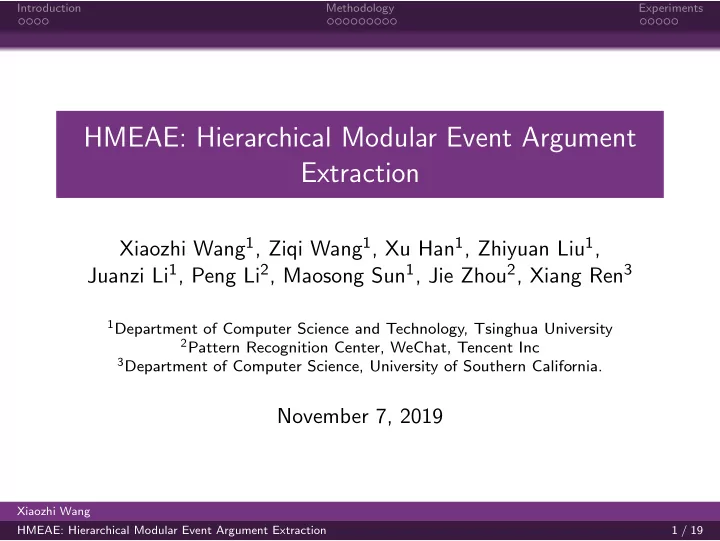

Introduction Methodology Experiments HMEAE: Hierarchical Modular Event Argument Extraction Xiaozhi Wang 1 , Ziqi Wang 1 , Xu Han 1 , Zhiyuan Liu 1 , Juanzi Li 1 , Peng Li 2 , Maosong Sun 1 , Jie Zhou 2 , Xiang Ren 3 1 Department of Computer Science and Technology, Tsinghua University 2 Pattern Recognition Center, WeChat, Tencent Inc 3 Department of Computer Science, University of Southern California. November 7, 2019 Xiaozhi Wang HMEAE: Hierarchical Modular Event Argument Extraction 1 / 19
Introduction Methodology Experiments Introduction • Event argument extraction (EAE): • Identify the entities serving as event arguments • Classify their argument roles • Second stage of Event Extraction Xiaozhi Wang HMEAE: Hierarchical Modular Event Argument Extraction 2 / 19
Introduction Methodology Experiments Introduction • The second stage of Event Extraction • The bottleneck of Event Extraction Xiaozhi Wang HMEAE: Hierarchical Modular Event Argument Extraction 3 / 19
Introduction Methodology Experiments Motivation • Existing methods treat argument roles as mutually independent • Some argument roles are conceptually closer than others Xiaozhi Wang HMEAE: Hierarchical Modular Event Argument Extraction 4 / 19
Introduction Methodology Experiments Motivation • Some argument roles are conceptually closer than others • How to utilize the concept hierarchy? Xiaozhi Wang HMEAE: Hierarchical Modular Event Argument Extraction 5 / 19
Introduction Methodology Experiments Our Model • Neural Module Networks • Imitating the concept hierarchical structure • Provide effective inductive bias for EAE Xiaozhi Wang HMEAE: Hierarchical Modular Event Argument Extraction 6 / 19
Introduction Methodology Experiments Overall architecture Xiaozhi Wang HMEAE: Hierarchical Modular Event Argument Extraction 7 / 19
Introduction Methodology Experiments Superordinate Concept Module (SCM) • One superordinate concept is corresponding to one module • Attention module, to highlight related information Xiaozhi Wang HMEAE: Hierarchical Modular Event Argument Extraction 8 / 19
Introduction Methodology Experiments Superordinate Concept Module (SCM) • One superordinate concept is corresponding to one module • Attention module, to highlight related information Xiaozhi Wang HMEAE: Hierarchical Modular Event Argument Extraction 9 / 19
Introduction Methodology Experiments Logic Union Module • Compose corresponding SCMs • Depends on the argument role Xiaozhi Wang HMEAE: Hierarchical Modular Event Argument Extraction 10 / 19
Introduction Methodology Experiments Argument Role Classifier • Given the embeddings • Predict whether this instance is of this argument role Xiaozhi Wang HMEAE: Hierarchical Modular Event Argument Extraction 11 / 19
Introduction Methodology Experiments Instance Encoder • Encode text and the candidate entity into embeddings • Feature Aggregator: pooling, aggregate into a global instance embedding • HMEAE is agnostic to the encoder Xiaozhi Wang HMEAE: Hierarchical Modular Event Argument Extraction 12 / 19
Introduction Methodology Experiments Instance Encoder • Encode text and the candidate entity into embeddings • Feature Aggregator: pooling, aggregate into a global instance embedding • HMEAE is agnostic to the encoder Xiaozhi Wang HMEAE: Hierarchical Modular Event Argument Extraction 13 / 19
Introduction Methodology Experiments Instance Encoder • Encode text and the candidate entity into embeddings • Feature Aggregator: pooling, aggregate into a global instance embedding • HMEAE is agnostic to the encoder Xiaozhi Wang HMEAE: Hierarchical Modular Event Argument Extraction 14 / 19
Introduction Methodology Experiments Overall Results Argument Role Method Classification P R F1 Li’s Joint 64.7 44.4 52.7 DMCNN 62.2 46.9 53.5 RBPB 54.1 53.5 53.8 JRNN 54.2 55.4 56.7 dbRNN 66.2 52.8 58.7 HMEAE (CNN) 57.3 54.2 55.7 DMBERT 58.8 55.8 57.2 HMEAE (BERT) 62.2 56.6 59.3 Table 1: The overall results (%) on ACE 2005. Xiaozhi Wang HMEAE: Hierarchical Modular Event Argument Extraction 15 / 19
Introduction Methodology Experiments Overall Results Argument Role Method Classification P R F1 DISCERN-R 7.9 7.4 7.7 Washington4 32.1 5.0 8.7 CMU CS Event1 31.2 4.9 8.4 Washington1 26.5 6.8 10.8 DMCNN 17.9 16.0 16.9 HMEAE (CNN) 15.3 22.5 18.2 DMBERT 22.6 24.7 23.6 HMEAE (BERT) 24.8 25.4 25.1 Table 2: The overall results (%) on TAC KBP 2016. Xiaozhi Wang HMEAE: Hierarchical Modular Event Argument Extraction 16 / 19
Introduction Methodology Experiments Case Study • Do the SCMs really capture its corresponding concepts? Barry 0.60 Diller on Wednesday 0.45 quit as 0.30 chief of Vivendi 0.15 Universal Entertainment Person Org Time Figure 1: Heatmap for attention scores of three SCMs on the left sentence. Xiaozhi Wang HMEAE: Hierarchical Modular Event Argument Extraction 17 / 19
Introduction Methodology Experiments Conclusion and Future work • A modular architecture imitating a prior structure (concept hierarchy) can provide effective inductive bias • Other tasks? Other priors? • Automatic design the architecture? Xiaozhi Wang HMEAE: Hierarchical Modular Event Argument Extraction 18 / 19
Introduction Methodology Experiments The End Thanks for listening. Questions are welcome. (a) Code (b) Paper Xiaozhi Wang HMEAE: Hierarchical Modular Event Argument Extraction 19 / 19
Recommend
More recommend